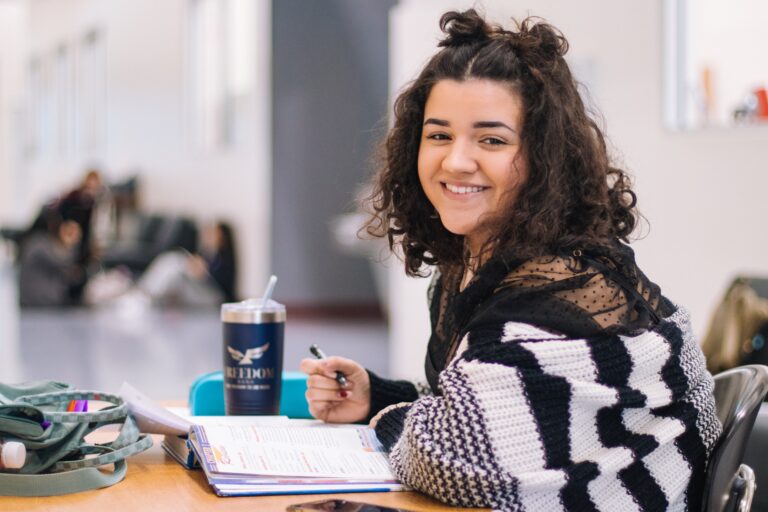College can be such an exciting milestone. Freedom is exhilarating, but on the flip side, it also comes with new responsibilities due to your financial independence.
You’re now in charge of your finances. And as you step onto your campus, you’ll be bombarded with offers of student bank accounts from different financial institutions.
So should you open a student bank account? What are its advantages compared to a regular bank account in the U.S.? Our team at Remitly put together this guide to answer these common questions and help you make an informed decision about student checking accounts.
Student checking account vs. regular account
Essentially, a student bank account is like a regular bank account in terms of function.
You can usually use student bank accounts to write checks, make debit card purchases, and withdraw money from an ATM. In addition, you can arrange to have a direct deposit made into a student account and transfer money in and out of one from a savings account or a checking account at another bank.
What makes student bank accounts different from a conventional checking account is that it is available only to people with student status. Often, the monthly maintenance fees and other fees are lower, and the account may come with additional perks geared toward the needs of students.
Most banks and credit unions will require you to show proof that you’re a student at a high school, college, university, or vocational program to open a student checking account. They may ask to see a student ID, an official transcript, or a letter from the school’s registrar that confirms your enrollment.
Typical student bank account features
Banks develop their own student bank account programs, so each one you consider may have different features and perks. However, the following are some common features of student bank accounts.
Low or no minimum balance
Financial institutions know that students are just starting on their financial journey, so they’ll typically cut you some slack on certain aspects of banking. The minimum balance is one.
With a standard checking account, you may need to keep a minimum account balance of $100 or $1,000 to avoid a monthly maintenance fee.
Students often only need to maintain a balance of $25 or less. In some cases, there may not be any minimum checking account balance required at all.
For example, TD Bank requires you to maintain a minimum daily balance of $100 in their TD Convenience Checking Account but has no minimum balance requirements on their student account as of June 2023.
Low or no initial deposit
With a typical checking account, you generally need to make an initial deposit when you open the account. For example, a bank might require you to deposit checks or cash that total $50 or $100.
For student bank accounts, some financial institutions set the opening deposit requirement lower or waive it entirely. For example, TD Bank offers a $0 minimum deposit upon opening the account.
Low or no overdraft fees
An overdraft happens when you spend more money than you have in your account, causing the balance to go into the negative. With regular checking accounts, most banks assess a fee for every overdraft transaction and may begin charging daily fees after the account remains overdrawn for a certain number of days.
As they’re relatively new to managing their finances, students are still learning to make financial decisions, and financial institutions are often more forgiving to students in terms of overdraft loans.
Wells Fargo, for example, charges a $35 overdraft fee per item, but those with a student account don’t get charged this fee.
Some banks also offer overdraft protection on student checking accounts. With this feature, you connect a line of credit or a savings account to your checking account. If you overdraw, the bank will automatically borrow from the line or transfer money from your savings account.
In some cases, there is a fee for using overdraft protection, but some banks may waive this on a student checking account.
Lower fees
Banks might charge monthly fees if you don’t meet the minimum daily balance or don’t receive a certain number of direct deposits every month. Financial institutions know that students need help to meet these requirements, so most banks waive these sorts of fees for students.
Chase, for instance, has a $12 monthly fee for their regular bank account holders. Students don’t pay this fee for up to five years while they’re enrolled in college. After graduation, the service charge is $6 as long as the account is active.
Banks may also charge an ATM fee if account holders use an ATM from a different network. Some banks waive this fee for students as well. For example, Truist Financial charges $3 for non-Truist ATM withdrawals, but they don’t charge this fee for the first two non-Truist ATM withdrawals every statement cycle for students.

Student bank account rewards
Many banks provide special benefits on their student checking accounts to attract new depositors. Some offer account opening bonuses that range from $100 to $150. With this type of perk, the bank will actually deposit money in your student checking account when you open it, giving you some extra cash.
Other banks get more creative with offers of cashback on purchases relevant to college students. For example, GO2bank offers 7% cash back on electronic gift card purchases.
And then there are banks that know how to execute the perfect way to market their products—referral marketing.
Financial institutions like SoFi know that students are the best advocate for their products to friends who are also in college. Thus, they’ve set up attractive referral systems that give students cash rewards if they can get their friends to open an account.
Further reading: 5 Top Language Apps for Learning English
Are international students eligible for a student bank account?
Some banks in the U.S. require you to be a U.S. resident or citizen before you can open a regular bank account.
However, a non-U.S. citizen or resident can often find a way around this issue by submitting their Individual Taxpayer Identification Number (ITIN) in place of a Social Security number (SSN).
International students can also easily open a student bank account. Most banks will need the following requirements instead:
- Passport
- Another photo ID like your student card, a driver’s license, or another government-issued photo ID
- Proof of enrollment, like a transcript or letter from the registrar
- Proof of residence and your residential address
- Minimum deposit
Most financial institutions offer the same perks mentioned above to international students. However, some go beyond their usual student account benefits to help ease the transition process for international students. HSBC, for instance, provides a 30-day SIM card with unlimited international calls for free.
Further reading: What Is the Difference Between a Checking and a Savings Account?

How to compare student bank accounts
Plenty of student checking accounts are available in the U.S. Most financial institutions offer at least one, so you have many banking options to consider. To ensure that you choose the right account, ask the following questions.
Is the bank member of FDIC?
The Federal Deposit Insurance Corporation or FDIC protects account holders from loss in the event of a bank failure. When you deposit money in a bank that is a member of the FDIC, you’re protected for up to $250,000.
Does the account include online and mobile banking?
Being able to access your information through a mobile app or website can help you keep closer tabs on your card transactions and deposits, reducing the risk of overdraft. Find out if mobile and online banking are standard features of the student checking account and whether there is a monthly service fee for using it.
Also, find out what you can do with the app or website.
Can you make mobile check deposits to avoid coming into the bank to deposit money? Are you able to send transfers to checking and savings accounts at other banks?
Does the mobile app or website provide personal finance tools like a budget planner? Can you get text alerts and/or email notifications about account activity or overdrafts?
What are the monthly fees?
Will you be responsible for paying monthly maintenance fees? If so, will the bank waive them if you maintain a minimum balance? What other fees may you be responsible for paying?
Are the branch and ATM locations convenient?
Find out how many ATMs and branches the bank has in the area where you’re living and studying. Even if you plan to do most of your banking online, it’s still nice to know that you can stop into a branch if you need assistance.
What happens when you’re no longer a student?
After your expected graduation date, your student checking account may convert to a traditional one. As a result, it makes sense to find out what will happen when you’re no longer an eligible student.
Do I need an adult co-owner?
Depending on your age, the bank may require you to have someone over the age of 18 on your account as a co-owner.
Even if it’s not required, the bank may allow you to name an adult co-owner if you wish. Adding a trusted family member to your account can be a smart move. This way, someone else will be able to access your student bank account and receive information about it in the event of an emergency.
Am I protected from unauthorized card transactions?
Debit cards can become compromised through data breaches at retailers and other organizations. When this happens, someone may be able to get your debit card number and use it to make unauthorized transactions.
Banks usually allow you to dispute fraudulent charges and receive money back when you’re a victim. However, you may need to notify the bank of the transaction within a certain period of time. Make sure you know what the rules are and what protections are in place to protect your money.
Find the right student bank account for you
Now that you know what a student bank account is and what to look for when opening one, you’re ready to start researching your options. Check out the websites for online and local banks in your area to learn more about their accounts and get on your way to opening your student account.

